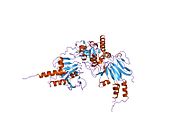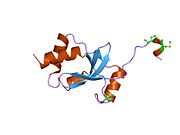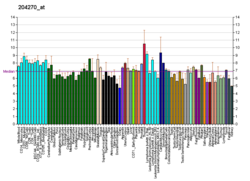SKI protein
| SKI | |||||||||||||||||||||||||||||||||||||||||||||||||||
|---|---|---|---|---|---|---|---|---|---|---|---|---|---|---|---|---|---|---|---|---|---|---|---|---|---|---|---|---|---|---|---|---|---|---|---|---|---|---|---|---|---|---|---|---|---|---|---|---|---|---|---|
 | |||||||||||||||||||||||||||||||||||||||||||||||||||
| |||||||||||||||||||||||||||||||||||||||||||||||||||
| Identifiers | |||||||||||||||||||||||||||||||||||||||||||||||||||
| Aliases | SKI, SKI proto-oncogene, SGS, SKV | ||||||||||||||||||||||||||||||||||||||||||||||||||
| External IDs | OMIM: 164780; MGI: 98310; HomoloGene: 31124; GeneCards: SKI; OMA:SKI - orthologs | ||||||||||||||||||||||||||||||||||||||||||||||||||
| |||||||||||||||||||||||||||||||||||||||||||||||||||
| |||||||||||||||||||||||||||||||||||||||||||||||||||
| |||||||||||||||||||||||||||||||||||||||||||||||||||
| |||||||||||||||||||||||||||||||||||||||||||||||||||
| |||||||||||||||||||||||||||||||||||||||||||||||||||
| Wikidata | |||||||||||||||||||||||||||||||||||||||||||||||||||
| |||||||||||||||||||||||||||||||||||||||||||||||||||
The SKI protein is a nuclear proto-oncogene that is associated with tumors at high cellular concentrations.[5] SKI has been shown to interfere with normal cellular functioning by both directly impeding expression of certain genes inside the nucleus of the cell as well as disrupting signaling proteins that activate genes.[6]
SKI negatively regulates transforming growth factor-beta (TGF-beta) by directly interacting with Smads and repressing the transcription of TGF-beta responsive genes.[7] This has been associated with cancer due to the large number of roles that peptide growth factors, of which TGF-beta are a subfamily, play in regulating cellular functions such as cell proliferation, apoptosis, specification, and developmental fate.[8]
The name SKI comes from the Sloan-Kettering Institute where the protein was initially discovered.
Structure
Gene
The SKI proto-oncogene is located at a region close to the p73 tumor suppressor gene at the locus 1p36.3 locus of a gene, suggesting a similar function to the p73 gene.[9]
Protein

The SKI protein has a 728 amino acid sequence, with multiple domains. It is expressed both inside and outside of the nucleus.[9] It is in the same family as the SnoN protein. The different domains have different functions, with the primary domains interacting with Smad proteins. The protein has a helix-turn-helix motif, a cysteine and histidine rich area which gives rise to the zinc finger motif, a basic amino acid region, and leucine zipper. All these domains, including a proline rich region, are consistent with the fact that the protein must have domains that allow it to interact with other proteins.[9] The protein also has hydrophobic regions which come into contact with Smad proteins rich in leucine and phenylalanine amino acid regions.[11] Recent studies have suggested a domain similar to the Dachshund protein. The SKI-Dachshund homology domain (SKI-DHD) contains the helix turn helix domains of the protein and the beta-alpha-beta turn motifs.[7]
Function
The SKI oncogene is present in all cells, and is commonly active during development. Specifically, avian fibroblasts depend on the SKI protein as a transcription co-regulator inducing transformation.[9] The aforementioned DHD region is specifically employed for protein-protein interactions, while the 191 amino acid C terminus mediates oligomerization.[7] Recent research shows that the SKI protein in cancerous cells acts as a suppressor, inhibiting transforming growth factor β (TGF- β) signaling. TGF- β is a protein which regulates cell growth. Signaling is regulated by a family of proteins called the Smad proteins. SKI is present in all adult and embryonic cells at low levels, however an over expression of the protein is characteristic of tumor cells.[11] It is thought that high levels of SKI protein inactivate tumor suppression by displacement of other proteins and interference with the signaling pathway of TGF- β.[9] The SKI protein and the CPB protein compete for binding with the Smad proteins, specifically competing with the Smad-3 and CReB-binding protein interactions. SKI also directly interacts with the R-Smad ∙ Smad-4 complex, which directly represses normal transcription of the TGF-β responsive genes, inactivating the cell's ability to stop growth and division, creating cancerous cells.[11]
SKI has been linked to various cancers including human melanomas, esophageal squamous cell carcinoma, cervical cancer and the process of tumor progression. The link of SKI with human melanoma has been the most studied area of the protein's link to cancer. Currently it is thought that the SKI protein prevents response to TFG- β levels, causing tumor formation.[9]
Related research
Other research has identified proteins similar to Ski. The SnoN protein was identified as a similar protein and is often discussed in conjugation with the Ski protein in publications. Recent research suggests that the role of SnoN could be somewhat different, and could potentially even play an antagonistic role.[12]
Other recent studies have determined Fussel-15 and Fussel-18 to be homologous to the Ski/Sno family of proteins. Fussel-15 has been found to play much the same role as the Ski/Sno proteins, however its expression is not as ubiquitous as the Ski/Sno proteins. Fussel-18 has been found to have an inhibitory role in the TGF-beta signaling.[13]
Dachshund and SKIDA1 are also in the Ski/Sno/Dac family (InterPro: IPR003380, IPR023216.[14]
Interactions
SKI protein has been shown to interact with:
- HIPK2,[15]
- MECP2,[16]
- Mothers against decapentaplegic homolog 1[15] and
- Mothers against decapentaplegic homolog 2,[15][17]
- Mothers against decapentaplegic homolog 3,[15][18]
- NFIX,[19]
- Promyelocytic leukemia protein,[20]
- SKIL,[21] and
- SNW1.[22][23][24]
References
- ^ a b c GRCh38: Ensembl release 89: ENSG00000157933 – Ensembl, May 2017
- ^ a b c GRCm38: Ensembl release 89: ENSMUSG00000029050 – Ensembl, May 2017
- ^ "Human PubMed Reference:". National Center for Biotechnology Information, U.S. National Library of Medicine.
- ^ "Mouse PubMed Reference:". National Center for Biotechnology Information, U.S. National Library of Medicine.
- ^ Vignais ML (February 2000). "[Ski and SnoN: antagonistic proteins of TGFbeta signaling]". Bull Cancer (in French). 87 (2): 135–7. PMID 10705283.
- ^ Cell 2002;111:1-20.
- ^ a b c Wilson JJ, Malakhova M, Zhang R, Joachimiak A, Hegde RS (May 2004). "Crystal structure of the dachshund homology domain of human SKI". Structure. 12 (5): 785–92. doi:10.1016/j.str.2004.02.035. PMID 15130471.
- ^ Whitman M (August 1998). "Smads and early developmental signaling by the TGFbeta superfamily". Genes Dev. 12 (16): 2445–62. doi:10.1101/gad.12.16.2445. PMID 9716398.
- ^ a b c d e f Reed JA, Lin Q, Chen D, Mian IS, Medrano EE (June 2005). "SKI pathways inducing progression of human melanoma". Cancer Metastasis Rev. 24 (2): 265–72. doi:10.1007/s10555-005-1576-x. PMID 15986136. S2CID 23664913.
- ^ PDB: 1SBX; Wilson JJ, Malakhova M, Zhang R, Joachimiak A, Hegde RS (May 2004). "Crystal structure of the dachshund homology domain of human SKI". Structure. 12 (5): 785–92. doi:10.1016/j.str.2004.02.035. PMID 15130471.
- ^ a b c Chen W, Lam SS, Srinath H, Schiffer CA, Royer WE, Lin K (April 2007). "Competition between Ski and CREB-binding protein for binding to Smad proteins in transforming growth factor-beta signaling". J. Biol. Chem. 282 (15): 11365–76. doi:10.1074/jbc.M700186200. PMID 17283070.
- ^ Ramel MC, Emery CM, Emery CS, Foulger R, Goberdhan DC, van den Heuvel M, Wilson C (April 2007). "Drosophila SnoN modulates growth and patterning by antagonizing TGF-beta signalling". Mech. Dev. 124 (4): 304–17. doi:10.1016/j.mod.2006.12.006. PMID 17289352. S2CID 14867669.
- ^ Arndt S, Poser I, Moser M, Bosserhoff AK (April 2007). "Fussel-15, a novel Ski/Sno homolog protein, antagonizes BMP signaling". Mol. Cell. Neurosci. 34 (4): 603–11. doi:10.1016/j.mcn.2007.01.002. PMID 17292623. S2CID 22992983.
- ^ "Conserved Protein Domain Ski_Sno". NCBI.
- ^ a b c d Harada J, Kokura K, Kanei-Ishii C, Nomura T, Khan MM, Kim Y, Ishii S (October 2003). "Requirement of the co-repressor homeodomain-interacting protein kinase 2 for ski-mediated inhibition of bone morphogenetic protein-induced transcriptional activation". J. Biol. Chem. 278 (40): 38998–9005. doi:10.1074/jbc.M307112200. PMID 12874272.
- ^ Kokura K, Kaul SC, Wadhwa R, Nomura T, Khan MM, Shinagawa T, Yasukawa T, Colmenares C, Ishii S (September 2001). "The Ski protein family is required for MeCP2-mediated transcriptional repression". J. Biol. Chem. 276 (36): 34115–21. doi:10.1074/jbc.M105747200. PMID 11441023.
- ^ Luo K, Stroschein SL, Wang W, Chen D, Martens E, Zhou S, Zhou Q (September 1999). "The Ski oncoprotein interacts with the Smad proteins to repress TGFbeta signaling". Genes Dev. 13 (17): 2196–206. doi:10.1101/gad.13.17.2196. PMC 316985. PMID 10485843.
- ^ Ueki N, Hayman MJ (August 2003). "Direct interaction of Ski with either Smad3 or Smad4 is necessary and sufficient for Ski-mediated repression of transforming growth factor-beta signaling". J. Biol. Chem. 278 (35): 32489–92. doi:10.1074/jbc.C300276200. PMID 12857746.
- ^ Tarapore P, Richmond C, Zheng G, Cohen SB, Kelder B, Kopchick J, Kruse U, Sippel AE, Colmenares C, Stavnezer E (October 1997). "DNA binding and transcriptional activation by the Ski oncoprotein mediated by interaction with NFI". Nucleic Acids Res. 25 (19): 3895–903. doi:10.1093/nar/25.19.3895. PMC 146989. PMID 9380514.
- ^ Khan MM, Nomura T, Kim H, Kaul SC, Wadhwa R, Shinagawa T, Ichikawa-Iwata E, Zhong S, Pandolfi PP, Ishii S (June 2001). "Role of PML and PML-RARalpha in Mad-mediated transcriptional repression". Mol. Cell. 7 (6): 1233–43. doi:10.1016/s1097-2765(01)00257-x. PMID 11430826.
- ^ Cohen SB, Zheng G, Heyman HC, Stavnezer E (February 1999). "Heterodimers of the SnoN and Ski oncoproteins form preferentially over homodimers and are more potent transforming agents". Nucleic Acids Res. 27 (4): 1006–14. doi:10.1093/nar/27.4.1006. PMC 148280. PMID 9927733.
- ^ Prathapam T, Kühne C, Hayman M, Banks L (September 2001). "Ski interacts with the evolutionarily conserved SNW domain of Skip". Nucleic Acids Res. 29 (17): 3469–76. doi:10.1093/nar/29.17.3469. PMC 55893. PMID 11522815.
- ^ Dahl R, Wani B, Hayman MJ (March 1998). "The Ski oncoprotein interacts with Skip, the human homolog of Drosophila Bx42". Oncogene. 16 (12): 1579–86. doi:10.1038/sj.onc.1201687. PMID 9569025. S2CID 27752352.
- ^ Leong GM, Subramaniam N, Figueroa J, Flanagan JL, Hayman MJ, Eisman JA, Kouzmenko AP (May 2001). "Ski-interacting protein interacts with Smad proteins to augment transforming growth factor-beta-dependent transcription". J. Biol. Chem. 276 (21): 18243–8. doi:10.1074/jbc.M010815200. PMID 11278756.
Further reading
- Medrano EE (2003). "Repression of TGF-beta signaling by the oncogenic protein SKI in human melanomas: consequences for proliferation, survival, and metastasis". Oncogene. 22 (20): 3123–9. doi:10.1038/sj.onc.1206452. PMID 12793438. S2CID 2566398.
- Nomura N, Sasamoto S, Ishii S, Date T, Matsui M, Ishizaki R (1989). "Isolation of human cDNA clones of ski and the ski-related gene, sno". Nucleic Acids Res. 17 (14): 5489–500. doi:10.1093/nar/17.14.5489. PMC 318172. PMID 2762147.
- Chaganti RS, Balazs I, Jhanwar SC, Murty VV, Koduru PR, Grzeschik KH, Stavnezer E (1987). "The cellular homologue of the transforming gene of SKV avian retrovirus maps to human chromosome region 1q22----q24". Cytogenet. Cell Genet. 43 (3–4): 181–6. doi:10.1159/000132318. PMID 3026737.
- Pearson-White S (1993). "SnoI, a novel alternatively spliced isoform of the ski protooncogene homolog, sno". Nucleic Acids Res. 21 (19): 4632–8. doi:10.1093/nar/21.19.4632. PMC 311202. PMID 8233802.
- Nagase T, Nomura N, Ishii S (1993). "Complex formation between proteins encoded by the ski gene family". J. Biol. Chem. 268 (18): 13710–6. doi:10.1016/S0021-9258(18)86915-0. PMID 8514802.
- Tarapore P, Richmond C, Zheng G, Cohen SB, Kelder B, Kopchick J, Kruse U, Sippel AE, Colmenares C, Stavnezer E (1997). "DNA binding and transcriptional activation by the Ski oncoprotein mediated by interaction with NFI". Nucleic Acids Res. 25 (19): 3895–903. doi:10.1093/nar/25.19.3895. PMC 146989. PMID 9380514.
- Dahl R, Wani B, Hayman MJ (1998). "The Ski oncoprotein interacts with Skip, the human homolog of Drosophila Bx42". Oncogene. 16 (12): 1579–86. doi:10.1038/sj.onc.1201687. PMID 9569025. S2CID 27752352.
- Cohen SB, Zheng G, Heyman HC, Stavnezer E (1999). "Heterodimers of the SnoN and Ski oncoproteins form preferentially over homodimers and are more potent transforming agents". Nucleic Acids Res. 27 (4): 1006–14. doi:10.1093/nar/27.4.1006. PMC 148280. PMID 9927733.
- Luo K, Stroschein SL, Wang W, Chen D, Martens E, Zhou S, Zhou Q (1999). "The Ski oncoprotein interacts with the Smad proteins to repress TGFbeta signaling". Genes Dev. 13 (17): 2196–206. doi:10.1101/gad.13.17.2196. PMC 316985. PMID 10485843.
- Sun Y, Liu X, Eaton EN, Lane WS, Lodish HF, Weinberg RA (1999). "Interaction of the Ski oncoprotein with Smad3 regulates TGF-beta signaling". Mol. Cell. 4 (4): 499–509. doi:10.1016/S1097-2765(00)80201-4. PMID 10549282.
- Akiyoshi S, Inoue H, Hanai J, Kusanagi K, Nemoto N, Miyazono K, Kawabata M (2000). "c-Ski acts as a transcriptional co-repressor in transforming growth factor-beta signaling through interaction with smads". J. Biol. Chem. 274 (49): 35269–77. doi:10.1074/jbc.274.49.35269. PMID 10575014.
- Steffan JS, Kazantsev A, Spasic-Boskovic O, Greenwald M, Zhu YZ, Gohler H, Wanker EE, Bates GP, Housman DE, Thompson LM (2000). "The Huntington's disease protein interacts with p53 and CREB-binding protein and represses transcription". Proc. Natl. Acad. Sci. U.S.A. 97 (12): 6763–8. Bibcode:2000PNAS...97.6763S. doi:10.1073/pnas.100110097. PMC 18731. PMID 10823891.
- Khan MM, Nomura T, Kim H, Kaul SC, Wadhwa R, Shinagawa T, Ichikawa-Iwata E, Zhong S, Pandolfi PP, Ishii S (2001). "Role of PML and PML-RARalpha in Mad-mediated transcriptional repression". Mol. Cell. 7 (6): 1233–43. doi:10.1016/S1097-2765(01)00257-X. PMID 11430826.
- Kokura K, Kaul SC, Wadhwa R, Nomura T, Khan MM, Shinagawa T, Yasukawa T, Colmenares C, Ishii S (2001). "The Ski protein family is required for MeCP2-mediated transcriptional repression". J. Biol. Chem. 276 (36): 34115–21. doi:10.1074/jbc.M105747200. PMID 11441023.
- Prathapam T, Kühne C, Hayman M, Banks L (2001). "Ski interacts with the evolutionarily conserved SNW domain of Skip". Nucleic Acids Res. 29 (17): 3469–76. doi:10.1093/nar/29.17.3469. PMC 55893. PMID 11522815.
- Reed JA, Bales E, Xu W, Okan NA, Bandyopadhyay D, Medrano EE (2001). "Cytoplasmic localization of the oncogenic protein Ski in human cutaneous melanomas in vivo: functional implications for transforming growth factor beta signaling". Cancer Res. 61 (22): 8074–8. PMID 11719430.
- Pessah M, Marais J, Prunier C, Ferrand N, Lallemand F, Mauviel A, Atfi A (2002). "c-Jun associates with the oncoprotein Ski and suppresses Smad2 transcriptional activity". J. Biol. Chem. 277 (32): 29094–100. doi:10.1074/jbc.M202831200. PMID 12034730.
- Wu JW, Krawitz AR, Chai J, Li W, Zhang F, Luo K, Shi Y (2002). "Structural mechanism of Smad4 recognition by the nuclear oncoprotein Ski: insights on Ski-mediated repression of TGF-beta signaling". Cell. 111 (3): 357–67. doi:10.1016/S0092-8674(02)01006-1. PMID 12419246. S2CID 10390985.
- Dai P, Shinagawa T, Nomura T, Harada J, Kaul SC, Wadhwa R, Khan MM, Akimaru H, Sasaki H, Colmenares C, Ishii S (2002). "Ski is involved in transcriptional regulation by the repressor and full-length forms of Gli3". Genes Dev. 16 (22): 2843–8. doi:10.1101/gad.1017302. PMC 187484. PMID 12435627.
- He J, Tegen SB, Krawitz AR, Martin GS, Luo K (2003). "The transforming activity of Ski and SnoN is dependent on their ability to repress the activity of Smad proteins". J. Biol. Chem. 278 (33): 30540–7. doi:10.1074/jbc.M304016200. PMID 12764135.
- v
- t
- e
-
 1mr1: Crystal Structure of a Smad4-Ski Complex
1mr1: Crystal Structure of a Smad4-Ski Complex -
 1sbx: Crystal structure of the Dachshund-homology domain of human SKI
1sbx: Crystal structure of the Dachshund-homology domain of human SKI





















